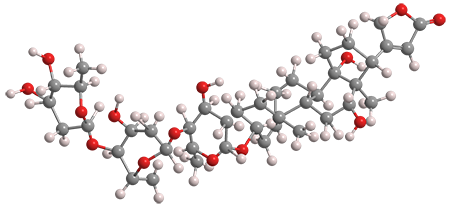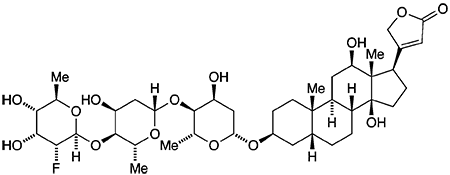What molecule am I?


Digoxin is a secondary glycoside produced by plants in the Digitalis (foxglove) genus that were used for medicinal purposes as long ago as the 18th century. In 1930, Sydney Smith at Burroughs Wellcome (London) isolated it from one species, D. lanata.
The US Food and Drug Administration approved the use of digoxin as a heart-disease medication in the late 1990s. It has been prescribed ever since under trade names such as Lanoxin for atrial fibrillation and heart failure. Digoxin, however, has a narrow therapeutic index; and drug interactions and adverse side effects are common. It has shown efficacy against some cancers, but other studies indicated that patients on digoxin have an increased risk of developing cancer.
Overdose is often fatal, as shown in the hazard information table. In 2003, a hospital nurse pleaded guilty to killing as many as 40 patients with digoxin and other heart medications.
Digoxin should not be confused with digitoxin1, which has one fewer hydroxyl group and is also a heart medication. For a new wrinkle on digoxin, see Molecule of the Future below.
1. CAS Reg. No. 71-63-6.
Digoxin ether hazard information
| Hazard class* | GHS code and hazard statement | |
|---|---|---|
| Acute toxicity, oral , category 2 | H300—Fatal if swallowed | |
| Acute toxicity, inhalation , category 3 | H331—Toxic if inhaled | |
| Carcinogenicity, category 2 | H351—Suspected of causing cancer | |
| Specific target organ toxicity, repeated exposure, category 2 | H373—May cause damage to organs through prolonged or repeated exposure | |
*Globally Harmonized System (GHS) of Classification and Labeling of Chemicals. Explanation of pictograms
Molecule of the Future
According to Xiang-Guo Hu, Chu-Yi Yu, and colleagues at Jiangxi Normal University (Nanchang, China) and the Chinese Academy of Sciences (Beijing), “The modification of carbohydrates with fluorine can profoundly affect molecules’ chemical and physical properties such as conformation, lipophilicity, and stability.” In December 2021, they reported the development of a scalable, stereoselective, de novo synthesis of C2-fluorinated Digitalis-type oligosaccharides, including digoxin.
The key steps in the authors’ synthesis were a Sharpless kinetic resolution and an organocatalytic fluorination of an aldehyde intermediate. The fluorinated digoxin1 was completed in 10 steps after the fluorination reaction.

It turned out that the fluorinated derivative exhibited ≈10 times less cytotoxicity toward A549 non–small-cell lung cancer cells than original digoxin. This result demonstrated that adding the fluorine atom indeed affected biological activity, which the authors state is worthy of additional research.
1. CAS Reg. No. 2769846-71-9.
Molecule of the Future
Once a month we bring you a newly discovered or developed molecule that has important implications for the future of chemistry or society in general. Look for it the third week of each month. Learn more about this month's Molecule of the Future below.
We're looking for more molecules of the future!
Do you have a suggestion for the next molecule of the future? Send your idea to MOTW.
This molecule was suggested by a reader. We present almost all of the molecules suggested by our readers. If you have a molecule you would like us to consider, please send us a message. And thank you for your interest in Molecule of the Week! —Ed.
Digoxin fast facts
| CAS Reg. No. | 20830-75-5 |
| SciFinder nomenclature | Card-20(22)-enolide, 3-[(O-2,6-dideoxy-β-D-ribo-hexopyranosyl-(1→4)-O-2,6-dideoxy-β-D-ribo-hexopyranosyl-(1→4)-2,6-dideoxy-β-D-ribo-hexopyranosyl) oxy]-12,14-dihydroxy-, (3β,5β,12β)- |
| Empirical formula | C41H64O14 |
| Molar mass | 780.94 g/mol |
| Appearance | White crystals or powder |
| Melting point | 230–265 °C (dec.) |
| Water solubility | 65 mg/L |

Learn more about this molecule from CAS, the most authoritative and comprehensive source for chemical information.
Molecule of the Week needs your suggestions!
If your favorite molecule is not in our archive, please send us a message. The molecule can be notable for its current or historical importance or for any quirky reason. Thank you!
Stay Ahead of the Chemistry Curve
Learn how ACS can help you stay ahead in the world of chemistry.

